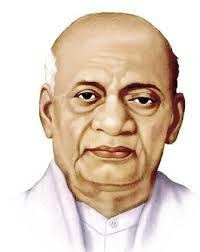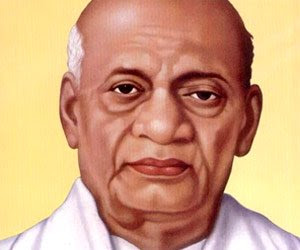BIOGRAPHY OF SARDAR VALLABHBHAI PATEL
 |
| Biography of Sardar Vallabhbhai Patel |
Date of Birth: Oct 31, 1875
Date of Death: Dec 15, 1950
Place of Birth: Gujarat
Biography of Sardar Vallabhbhai Patel:-
Vallabhbhai Jhaverbhai Patel was born at his maternal uncle’s house in Nadiad, Gujarat. His actual date of birth was never officially recorded Patel entered October 31st as his date of birth on his matriculation examination papers. He was the fourth son of Jhaverbhai and Ladba Patel, and lived in the village of Karamsad, in the Kheda district. Somabhai, Narsibhai, and Vithalbhai Patel (also a future political leader) were his elder brothers. He had a younger brother, Kashibhai, and a sister, Dahiba. Patel helped his father in the fields and bimonthly kept a day-long fast, abstaining from food and water a cultural observance that enabled him to develop physical toughness. He entered school late parental attention was focused on the eldest brothers, thus leading to a degree of neglect of Patel’s education. Patel traveled to attend schools in Nadiad, Petlad and Borsad, living self-sufficiently with other boys. He took his matriculation at the late age of 22; at this point, he was generally regarded by his elder relatives as an unambitious man destined for a commonplace job. But Patel himself harbored a plan he would pass the Pleader’s examination and become a lawyer. He would then set aside funds, travel to England, then train to become a barrister.
 |
| Biography of Sardar vallabhbhai patel |
 |
| Biography of Sardar Vallabhbhai Patel |
Her health suddenly worsened, and despite successful emergency surgery, she died. Patel was given a note informing him of his wife’s demise as he was cross-examining a witness in court. As per others who witnessed, Patel read the note, pocketed it and continued to intensely cross-examine the witness, and won the case. He broke the news to others only after the proceedings had ended. Patel himself decided against marrying again. He raised his children with the help of his family, and sent them to English-medium schools in Mumbai (then Bombay). At the age of 36, he journeyed to England and enrolled at the Middle Temple Inn in London. Finishing a 36-month course in 30 months, Patel topped his class despite having no previous college background. Patel settled in the city of Ahmedabad, and became one of the city’s most successful barristers. Wearing European-style clothes and urbane mannerisms, he also became a skilled bridge player at the Gujarat Club. His close friends would include his neighbours Dr. Balwantray and Nandubehn Kanuga, who would remain dear to him, and a young lawyer, Ganesh Vasudev Mavlankar. He had also made a pact with his brother Vithalbhai to support his entry into politics in Bombay, while Patel himself would remain in Ahmedabad and provide for the family. According to some of Patel’s friends, he nurtured ambitions to expand his practise and accumulate great wealth, and to provide his children with modern education.
 |
| Biography of Sardar Vallabhbhai Patel |
Vallabhbhai Patel was a major political and social leader of India and its struggle for independence and is credited for achieving the political integration of independent India. In India and across the world, he is known as Sardar Vallabhbhai Patel, where Sardar stands for Chief in many languages of India. Patel organized the peasants of Kheda, Borsad, and Bardoli in Gujarat in non-violent civil disobedience against the oppressive policies imposed by the British Raj becoming one of the most influential leaders in Gujarat. He rose to the leadership of the Indian National Congress and at the forefront of rebellions and political events organizing the party for elections in 1934 and 1937, and leading Indians into the Quit India movement. He was imprisoned by the British government on numerous occasions, especially from 1931 to 1934, and from 1942 to 1945.
 |
| Biography of Sardar Vallabhbhai Patel |
Becoming the first Home Minister and Deputy Prime Minister of India, Patel organized relief and rehabilitation efforts in the riot-struck Punjab and Delhi and led efforts to restore security. Patel took charge of the task to forge a united India from a plethora of semi-independent princely states, colonial provinces, and possessions. Patel employed an iron list in a velvet glove diplomacy frank political negotiations backed with the option (and the use) of military action to weld a nation that could emancipate its people without the prospect of divisions or civil conflict. His leadership obtained the peaceful and swift integration of all 565 princely states into the Republic of India. Patel’s initiatives spread democracy extensively across India and re-organized the states to help transform India into a modern federal republic. His admirers call him the Iron Man of India. He is also remembered as the “patron saint” of India’s civil servants for his defense of them against political attack, and for being one of the earliest and key defenders of property rights and free enterprise in independent India.





1 Comments
motivational
ReplyDeleteDarwan Singh Negi VC: World War 1 Victoria Cross WinnerDarwan Singh Negi VC: World War 1 Victoria Cross WinnerDarwan Singh Negi VC: World War 1 Victoria Cross WinnerDarwan Singh Negi VC: World War 1 Victoria Cross WinnerDarwan Singh Negi VC: World War 1 Victoria Cross WinnerDarwan Singh Negi VC: World War 1 Victoria Cross WinnerDarwan Singh Negi VC: World War 1 Victoria Cross WinnerDarwan Singh Negi VC: World War 1 Victoria Cross WinnerDarwan Singh Negi VC: World War 1 Victoria Cross WinnerDarwan Singh Negi VC: World War 1 Victoria Cross WinnerDarwan Singh Negi VC: World War 1 Victoria Cross Winner